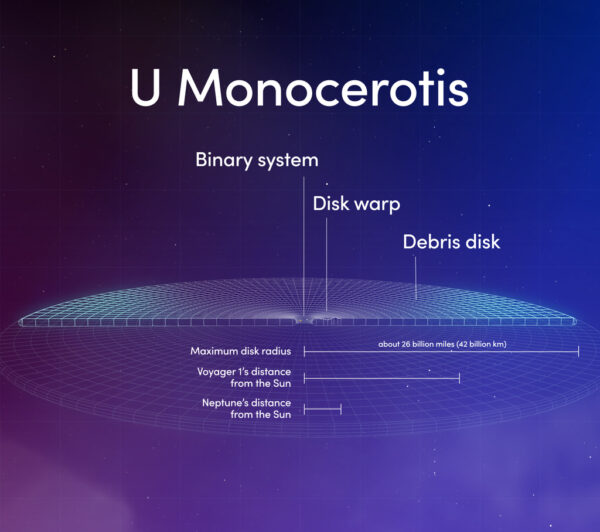Vanderbilt astronomers have painted their best picture yet of an RV Tauri variable-a rare type of stellar binary, in which two stars orbit each other within a sprawling disk of dust. To sketch its characteristics, the scientists mined a 130-year dataset that spans the widest range of light yet collected for one of these systems, from radio waves to X-rays.

"There are only about 300 known RV Tauri variables in the Milky Way galaxy," said Laura Vega, a former graduate student in the Fisk-Vanderbilt Master's-to-Ph.D. Bridge Program in a release. "We focused our study on the second-brightest system, named U Monocerotis, which is now the first of these systems from which X-rays have been detected."
Led by Vega, the paper describing the findings was published online in The Astrophysical Journal on March 12.
U Mon is in the constellation Monoceros, about 3,600 light years from Earth. Its two stars circle each other every six and a half years or so.

This evolved system has many features and behaviors in common with newly formed binaries, said co-author Keivan Stassun, Stevenson Professor of Physics and Astronomy and Vega's doctoral adviser. Both types of binaries are embedded in disks of gas and dust, and in both cases, the disks can form warps or clumps. In young binaries, these distortions might signal the beginnings of planet formation.
"We still have questions about a feature in U Mon's disk, which may be answered by future radio observations," Stassun said. "It's fascinating how closely these two binary life stages mirror each other."
The primary star, an elderly yellow supergiant, has about twice the Sun's mass but has billowed to 100 times the Sun's size. Scientists know less about the companion star, but they think it's of similar mass and much younger than the primary.
The cool disk around both stars is composed of gas and dust ejected by the primary star as it evolved. Using radio observations from the Submillimeter Array on Maunakea, Hawaii, Vega's team estimated that the disk surrounding the binary is 51 billion miles across.

As part of their dance, the companion star is thought to funnel the primary star's gas into its own disk, which heats up as a result and generates X-rays. This could explain the X-rays detected in 2016 by the European Space Agency's XMM-Newton satellite.
"The XMM observations make U Mon the first RV Tauri variable detected in X-rays," said Kim Weaver, the XMM U.S. project scientist and an astrophysicist at NASA's Goddard Space Flight Center in Greenbelt, Maryland. "It's exciting to see ground- and space-based multiwavelength measurements come together to give us new insights into a long-studied system."
The earliest available measurement of the system, collected on Dec. 25, 1888, came from the archives of the American Association of Variable Star Observers, the international network of amateur and professional astronomers. AAVSO provided additional historical measurements ranging from the mid-1940s to present.
The researchers also used archived images cataloged by the Digital Access to a Sky Century @ Harvard, a program at the Harvard College Observatory dedicated to digitizing astronomical images from glass photographic plates made by ground-based telescopes between the 1880s and 1990s.
Vega completed her analysis of the U Mon system as a NASA Harriett G. Jenkins Predoctoral Fellow, a program funded by the NASA Office of STEM Engagement's Minority University Research and Education Project.
"Laura used this historical dataset to detect a characteristic that would otherwise appear only once in an astronomer's career," said co-author Rodolfo Montez Jr., an astrophysicist at the Center for Astrophysics | Harvard & Smithsonian. "It's a testament to how our knowledge of the universe builds over time."






